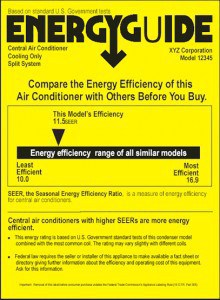What is the Difference Between EER and SEER?
If you are looking for a new air conditioner for your Southern California home, you have probably seen both EER and SEER numbers for different air

conditioning makes and models.
These two measurements are the same in that they both measure air conditioner’s energy efficiency. Yet they are also different and understanding them can help you make a more informed decision.
What is EER?
EER stands for Energy Efficiency Ratio. It was one of the first attempts to standardize how the energy efficiency of an air conditioner is calculated.
The EER of a particular air conditioner is calculated by dividing the input electrical power (measured in watts) by the amount of cooling created (measured in British Thermal Units or BTU’s) under a single set of conditions.
Typically, the condition for calculating EER is an outdoor temperature of 95°F and inside temperature of 80°F with 50% humidity.
How is SEER different?
The difference between EER and SEER is the “S”, which stands for seasonal.
Rather than measuring the energy efficiency of an air conditioner at one operating temperature, SEER is the calculation of how energy efficient the air conditioner is during the cooling season at varying temperatures.
Said another way, SEER takes into account how the EER is affected by different temperatures.
Where EER is calculated using a steady outside temperature of 95°F, SEER is calculated using a range of outside temperatures ranging from 65°F to 104°F.
[pt_view id=”9badeda1b4″]
Which rating should I pay attention to?
The U.S. government only mandates that air conditioners display SEER. However, many still show EER, as well. Both ratings can be helpful in different situations.
- EER is the efficiency you can expect from the air conditioner at peak cooling time (in the midst of the summer) because it is measured at only one, higher temperature.
- SEER is an average. It takes into account the highs and lows of a typical home’s cooling pattern.
For areas of the country where it is 95°F or higher most of the time the air conditioner is on, the EER is usually more accurate. For more moderate climates like Southern California, the SEER is a better measurement.
The important part is to compare apples to apples. So make sure you are comparing one air conditioner’s EER to another’s EER or SEER to SEER.
Comparing the EER of one model to the SEER of another will not be accurate.
Need help deciding on the right air conditioner for your Southern California home? Get a free, in-home estimate from Service Champions. Or check out our financing options if you’re looking for a way to afford you new cooling investment.

